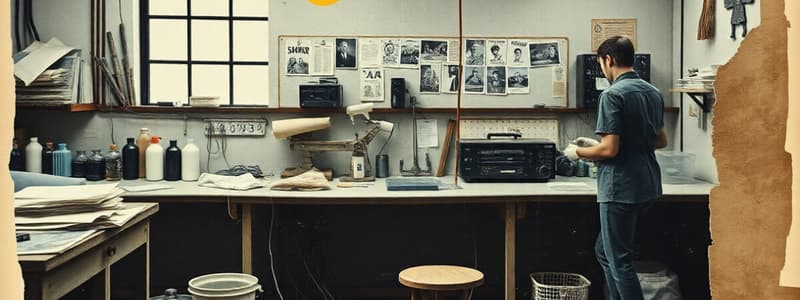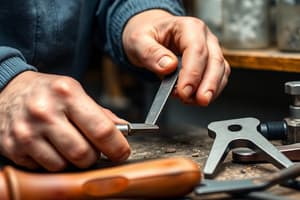Podcast
Questions and Answers
What is the first step in the clean-up process?
What is the first step in the clean-up process?
- Fast sweep of tabletop using hand brooms
- Quick tidy and chip spatter from own booth
- Unused material and electrodes to the front (correct)
- Empty scrap bin(s)
Which cleaning task involves using a push broom specifically?
Which cleaning task involves using a push broom specifically?
- Sweeping aisles and around instructor tables (correct)
- Cleaning helmets
- Quick tidy of booth
- Resweeping table tops of grinding dust
When should the scrap bin(s) be emptied during the clean-up?
When should the scrap bin(s) be emptied during the clean-up?
- As the last step of the clean-up (correct)
- Frequently throughout the clean-up
- At the beginning of the clean-up
- After sweeping the aisles
What step comes directly after sanding table tops?
What step comes directly after sanding table tops?
Which of the following tasks is focused on cleaning the work area and equipment?
Which of the following tasks is focused on cleaning the work area and equipment?
What is the typical height of an oxygen cylinder?
What is the typical height of an oxygen cylinder?
What is the pressure commonly found in standard acetylene cylinders at 70°F?
What is the pressure commonly found in standard acetylene cylinders at 70°F?
What safety device is associated with typical compressed gas cylinders?
What safety device is associated with typical compressed gas cylinders?
Which of the following statements about liquid oxygen cylinders is true?
Which of the following statements about liquid oxygen cylinders is true?
What is the maximum withdrawal rate for gas from a standard acetylene cylinder?
What is the maximum withdrawal rate for gas from a standard acetylene cylinder?
What material are most refillable gas cylinders traditionally made from?
What material are most refillable gas cylinders traditionally made from?
How does acetone interact with acetylene in a cylinder?
How does acetone interact with acetylene in a cylinder?
What common component is found inside acetylene cylinders?
What common component is found inside acetylene cylinders?
What is a significant advantage of using MAPP gas cylinders over acetylene cylinders?
What is a significant advantage of using MAPP gas cylinders over acetylene cylinders?
Why are safety devices in cylinders triggered by pressure in compressed gas cylinders?
Why are safety devices in cylinders triggered by pressure in compressed gas cylinders?
Which gas is primarily used for welding thin sections of metal, requiring low temperatures?
Which gas is primarily used for welding thin sections of metal, requiring low temperatures?
What is the approximate weight of an empty acetylene cylinder?
What is the approximate weight of an empty acetylene cylinder?
Why is it not recommended to use an adjustable wrench with oxy-fuel equipment?
Why is it not recommended to use an adjustable wrench with oxy-fuel equipment?
What potential risk is associated with improperly using gas cylinders?
What potential risk is associated with improperly using gas cylinders?
What type of cylinders are many fuel gases stored in at room temperature?
What type of cylinders are many fuel gases stored in at room temperature?
Which gas is noted for its stability but has limitations for welding due to its low flame temperature?
Which gas is noted for its stability but has limitations for welding due to its low flame temperature?
What is the maximum allowable withdrawal rate for acetylene from a cylinder?
What is the maximum allowable withdrawal rate for acetylene from a cylinder?
If an acetylene cylinder has a capacity of 130 cubic feet, what is the acceptable withdrawal rate it should not exceed?
If an acetylene cylinder has a capacity of 130 cubic feet, what is the acceptable withdrawal rate it should not exceed?
What could happen if a high withdrawal rate is applied to a liquefied gas cylinder?
What could happen if a high withdrawal rate is applied to a liquefied gas cylinder?
Which of the following gases are typically transported in a gaseous form?
Which of the following gases are typically transported in a gaseous form?
What might a lowering of the cylinder temperature indicate?
What might a lowering of the cylinder temperature indicate?
What is a common misconception regarding the pressure in a liquefied gas cylinder?
What is a common misconception regarding the pressure in a liquefied gas cylinder?
What happens if an oxy-fuel torch tip consumes acetylene at a rate exceeding one-seventh of the cylinder's volume?
What happens if an oxy-fuel torch tip consumes acetylene at a rate exceeding one-seventh of the cylinder's volume?
Which of the following is NOT a reason for using the specified withdrawal rates for acetylene?
Which of the following is NOT a reason for using the specified withdrawal rates for acetylene?
Flashcards are hidden until you start studying
Study Notes
Cleaning Responsibilities
- Unused material, electrodes, and chip spatter should be returned to the front of the booth
- Tabletops should be swept clean using a hand broom
- Tabletops should be sanded and swept again
- Booths should be swept clean
- Wire feeders should be swept into the centre of the aisles
- Helmets should be cleaned
- Aisles and around instructor tables should be swept
- Scrap bins should be emptied
Gases and Cylinders
- Acetylene is commonly used for welding, but MAPP gas and hydrogen can be used as alternatives.
- Propane is a stable gas, however, its low flame temperature limits its usefulness for welding.
- Oxygen and hydrogen combined create a low-temperature flame which is mostly used for welding aluminum.
- MAPP gas can be stored and shipped in lighter cylinders since it's not sensitive to shock.
- Empty acetylene cylinders weigh about 220 lbs, while empty MAPP cylinders weigh 50 lbs.
- Refillable cylinders are made of steel or aluminum and usually have a 1/4 inch thick steel wall.
- Oxygen, nitrogen, argon, hydrogen, and helium gases are compressed into cylinders made of high-strength steel or aluminum.
- Many fuel gases are supplied in liquid form at room temperature, stored at lower pressures in thin-walled steel or composite aluminum cylinders.
- Acetylene, hydrogen, and natural gas are shipped in a gaseous form, while propane, MAPP and other gases are shipped in liquid form.
- The pressure in a liquefied gas cylinder doesn't indicate the level of gas in the tank.
- High withdrawal rates from liquefied gas cylinders cause a pressure drop, lowering the cylinder temperature, and could freeze the regulator.
- Acetone absorbs acetylene, similar to how water absorbs carbon dioxide in a carbonated drink.
- Maximum withdrawal rate for acetylene cylinders should not exceed one-seventh of the total cylinder capacity per hour.
- A multiple cylinder manifold system allows for a larger volume of acetylene to be supplied to the work area.
- The maximum withdrawal rate for acetylene is 1/7th of the total volume per hour, but this might change.
- Acetylene cylinders are not seamless and have honeycombed interiors.
- Acetylene cylinders have a common pressure of 250 psi at 70°F.
- The maximum pressure used in an acetylene cylinder is 15 psi.
- Acetylene cylinders have safety devices that are triggered by heat (100°C or 212°F).
- Oxygen cylinders are typically 5 ft tall and weigh approximately 150 lbs when full.
- Liquid oxygen cylinders have the same height as standard oxygen cylinders but are twice the diameter and hold 12 times as much oxygen.
- An adjustable wrench is not recommended for use with oxy-fuel equipment.
- Specific wrenches are associated with oxy-fuel equipment, so check the wrench before using it.
Withdrawal Rates for ‘Standard’ Acetylene Cylinders
- If a 130 cubic feet acetylene cylinder is used with a torch that consumes 8 cubic feet per hour, the withdrawal rate is acceptable.
- If a 75 cubic feet acetylene cylinder is used with a torch that consumes 34 cubic feet per hour, the withdrawal rate is not acceptable.
- ‘Typical’ compressed gas oxygen cylinders are seamless and have an internal pressure of 2200 psi at 70 degrees Fahrenheit.
- ‘Typical’ acetylene cylinders are not seamless, have honeycombed interiors, a common pressure of 250 psi and a maximum pressure of 15 psi.
- ‘Typical’ compressed gas oxygen cylinders are associated with safety devices triggered by pressure.
- ‘Typical’ acetylene cylinders are associated with safety devices triggered by heat (100⁰C or 212⁰F).
Studying That Suits You
Use AI to generate personalized quizzes and flashcards to suit your learning preferences.




